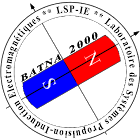, “Dual Simplex Method for Optimal Coordination of DOCR’s in Distribution System with D-FACTS,” International Journal of Information Science and Technology, vol. 3 N° 3, pp. 3-9, 2019.Abstract
Équipe 05
, “An Experimental Study on the Smart Home Concept with PV and Energy Management and Control Strategy Using an Open Source Platform,” Distributed Generation & Alternative Energy Journal, vol. 34 N 1, pp. 61-80, 2019.Abstract
, “Implementation of finite set model predictive current control for shunt active filter,” 9th International in Renewable Energy Congress (IREC), . 2018.Abstract
, “Optimal Coordination Time Interval for DOCRs in Presence of D-FACTS,” IEEE 5th International Congress on Information Science and Technology (CiSt), Marrakech, Morocco. pp. 477-480, 2018.Abstract
, “A Neural and Fuzzy Logic Based Control Scheme for a Shunt Active Power Filter,” Springer edition. Book Title: Recent Advances in Electrical Engineering and Control Applications. , pp. 201-211, 2017.
, “A Neural and Fuzzy Logic Based Control Scheme for a Shunt Active Power Filter,” Recent Advances in Electrical Engineering and Control Applications, pp. 201-211, 2017.Abstract
, “Impact of RDG Penetration on IDMT Overcurrent Relay Operation in Radial MV Distribution System,” International Conference on Recent Advances in Electrical Systems (ICRAES) 2016. 2016.
, “The Impact of TCSC on IDMT Relays in SLG Fault in Distribution Networks,” Med. J. Modeling . Simulation, 2016.
, “Intelligent active power filter based on ADALINEs and PI-neural under unbalanced and distorted voltages,” International Journal of Power and Energy Conversion, 2016.
, “ Optimal Coordination of DOCR for Radial Distribution Systems in Presence of TCSCL,” International Journal of Power Electronics and Drive Systems, 2016.
, “A New Learning and Fuzzy Strategy for Active Power Filtering,” Journal on Electrical Engineering and informatics (IJEEI journal), vol. 8 N°3, 2016.
, “Investigation of TCSC Controller Effect on IDMT Directional Over-current Relay,” World Conference on Technology, Innovation and Entrepreneurship. 2015.
, “Investigation of TCSC Controller Effect on IDMT Directional Over-current Relay,” Procedia - Social and Behavioral Sciences, vol. 195, pp. 2421-2429, 2015.
, “A Neural and Fuzzy Logic Controller to Improve the Performance of a Shunt Active Power Filter,” Revue des Sciences et de la Technologie (RST), publié par Université de Batna, vol. 6, No. 1, pp. 1-11, 2015.
, “Optimal Overcurrent Relays Coordination in the Presence Multi TCSC on Power Systems Using BBO Algorithm,” International Journal Intelligent Systems and Applications (IJISA), vol. 7, No. 2, pp. 13-20, 2015.
